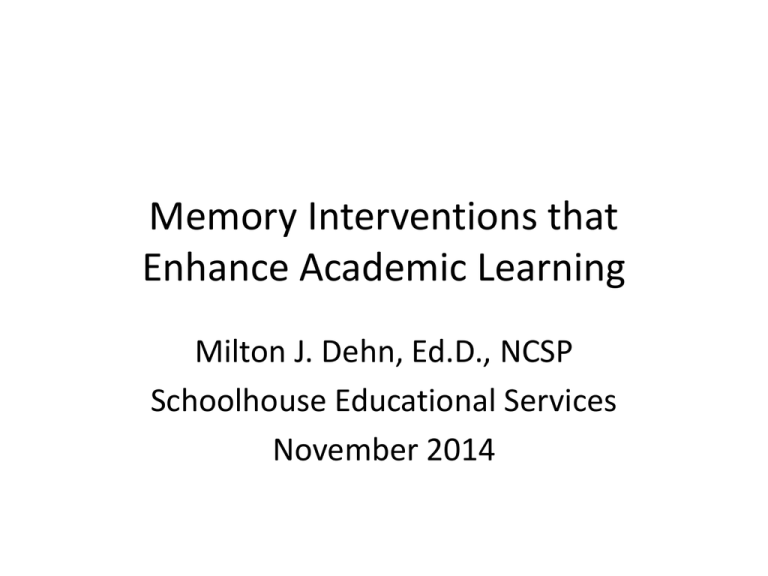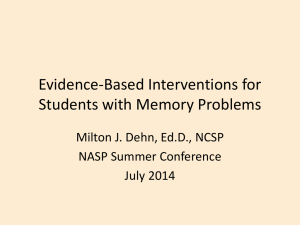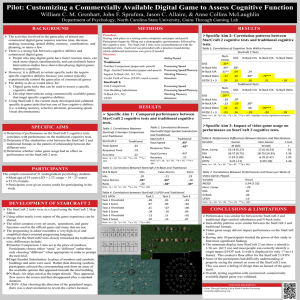
Memory Interventions that
Enhance Academic Learning
Milton J. Dehn, Ed.D., NCSP
Schoolhouse Educational Services
November 2014
Notice of Copyright, 2014
This PowerPoint and accompanying materials
are copyrighted by Milton J. Dehn and
Schoolhouse Educational Services, LLC. All
rights reserved. No photocopying, electronic
display, or electronic dissemination of these
materials is allowed without written
permission. For permission, contact
milt@psychprocesses.com
Workshop Information Sources
• Chapter in Essentials of Planning, Selecting,
and Tailoring Interventions for Unique
Learners
• Working Memory and Academic Learning
• Long-Term Memory Problems in Children
• Helping Students Remember
• Essentials of Processing Assessment, 2nd Ed.
• www.psychprocesses.com
• www.SchoolhouseEducationalServices.com
Presentation Overview
1.
2.
3.
4.
5.
Reducing cognitive load in the classroom
Working memory accommodations
Working memory strategies
Working memory exercises
Long-term memory strategies
Memory Interventions
1.
2.
3.
4.
5.
6.
7.
8.
They are evidence-based; brain-based
One-on-one, small group, classroom wide
Through trained parents/teachers
Includes direct and consultation/training
Kindergarten through adulthood
Exercises vs strategies
Some tied with academic skills & study skills
Accommodations included
Working Memory Definition
1. ST retention + processing = WM
2. “WM: the limited capacity to retain
information while simultaneously
manipulating the same or other information
for a short period of time”
3. Keeping information in mind from moment
to moment
4. STM is part of WM; WM “manages” STM as
needed
Video Link
Approaches to Improving WM
1. Reduce the “cognitive load” imposed on the
student (Tier I)
2. Directly increase WM capacity through the
use of training exercises (Tiers II and III)
3. The student can make more effective use of
existing WM capabilities by learning to use
strategies (Tiers 1 – 3))
4. Accommodations
Cognitive Load Theory
1.
2.
3.
4.
WM is a combination of processing & storage
“Cognitive Load” is the processing portion
Processing & storage both draw on WM capacity
Can focus attention on only 1 aspect of WM at a
time
5. The greater the processing demands/longer the
processing, the more info. lost from WM/STM
6. If focus on retention, processing may suffer
7. Cognitive load is the main determinant of
retention in WM (and STM)
Retention as a Function of Cognitive
Load
What Causes High Cognitive Load
1.
2.
3.
4.
5.
6.
7.
Novelty
Complexity
Disorganization
Multi-tasking
Verbosity
Environmental distractions
Irrelevant thoughts
Coping with Cognitive Load: Switching
1. To retain info. in WM, one must frequently
switch from processing to refreshing the info.
2. If the processing (cognitive load) is
demanding, there will be less switching and
more info. will be lost
3. Example: remember steps while completing
an online task
4. Switching is difficult for young children
Cognitive Load in the Classroom
1. Instruction easily overloads WM
1. By the nature of the material
2. By the manner it is presented
2. Focus on designing instruction that reduces
cognitive load
3. Typical classroom learning activities easily
overload WM
4. Load also created by the learner’s processing
Reducing Cognitive Load
1. Well designed instruction reduces load
1. Leaves capacity for retention & encoding of info.
2. Or, allow processing without need to
remember; e.g. facts in writing are available
3. Or, processing reminders are available
4. Teach students to alternate between
processing and refreshing
5. Students learn under low load conditions
Reducing Cognitive Load
1.
2.
3.
4.
5.
6.
7.
Only one step, process at a time
Allow time for processing and rehearsal
Allow self-paced processing
Provide external memory aids
Quite learning environment
Organized materials and presentations
Worked, partially-completed examples
1. Keep adding more for student to complete
Reducing Cognitive Load
1.
2.
3.
4.
Sequence material from simple to complex
Present material in an integrated way
Include visual presentation
Side by side information (being able to see as
all the information in an integrated fashion)
better than stacked information (e.g. computers)
5. Deliver directions “just in time”
Cognitive Load and Automaticity
1. Mastery or fluency frees up WM resources
1. Reading decoding and reading comprehension
2. Math problem solving
3. Written language
1. Organization and coordination
4. Long-term structures free up WM
5. Automaticity equals faster processing
WM Accommodations
1.
2.
3.
4.
5.
6.
7.
8.
Extended testing time
Repeating information
Repeating information in a simplified manner
Providing written checklists and reminders of
step-by-step procedures
One task at a time
Slow down presentation
Preferential seating to reduce distraction
Provide prompts and cues
WM and Written Expression
1. Signs of WM overload during written
expression: omitting words, repeating words,
forgetting what was going to say, can‘t start
2. Have the student express it orally first
3. Teacher “stores” it and says what student
said as student writes
4. Teacher writes part of sentence so that
student just needs to use closure to finish
WM and Math
1. Math demands a lot of both WM and LTM
2. Lighten the load by allowing written step-bystep procedures
3. Help to identify story problem words that
indicate the math procedures involved
4. Allow access to arithmetic fact tables
5. No timed math tests
6. Allow calculators
WM and Basic Reading Skills
1. Support student during decoding and
blending
2. Prompt by saying the first phoneme in a
syllable
3. Say the segmented phonemes/syllables
slowly after student has sounded them out
4. Have student say blended word smoothly
again after correct pronunciation
WM Rehearsal Strategies
1.
2.
3.
4.
5.
6.
Most have by age 10; 1st graders can learn
Serial and cumulative repetitive process
Good maintenance if overlearned
Increase length of list as student progresses
Require trainees to do during WM exercises
More effective than elaborate strategies?
Rehearsal Training Steps
1. Repeat first word until next delivered then add
next word to the repetition if cumulative
2. Or, deliver and repeat entire sequence at once
3. Have student repeat sequence several times,
then pause, then ask for response
4. Listen to see if student maintains correct
sequence while rehearsing
5. Have the student say the words faster
6. First aloud, then whisper, then subvocal
Criteria for Effective WM Exercises
1.
2.
3.
4.
5.
6.
Consistent high cognitive workloads
Processing and storage required during task
Program is adaptive
Extensive practice time
Evidence base cited
More than visual-spatial; some kind of verbal
processing and retention required
7. Encourages/requires a conscious strategy
Cogmed Training Details
1. Adaptive, game-like, internet-based training,
records everything
2. 25 sessions, 30 minutes each with 8
exercises, over 5 weeks
3. Child can do without assistance
4. Should not encourage use of strategies
Link
Research on Cogmed Training
1.
2.
3.
4.
5.
Improved WM, especially visual-spatial
Fluid reasoning sometimes improves
Math and reading sometimes improve
ADHD kids improved in WM; less hyperactivity
Holmes et al. found substantial and sustained
gains in WM and math
6. Two reviews critical; poor research design
7. Recent study with proper design: WM improved
Lumosity and Brain HQ
1.
2.
3.
4.
5.
6.
Numerous exercises; more than memory
Exercises based on research
Lots of n-back exercises
Are adaptive and appropriate
Affordable yearly, family plans
Can monitor learner’s progress
WM Training Impact on Brain
1. Takeuchi et al. (2010)
2. Adaptive training with 2 N-Back visual tasks
3. Increase in white matter correlated with
amount of training & improved performance
4. Mainly adjacent to the corpus callosum and
in white matter parietal region
5. Increased transfer of info, at the dorsolateral
prefrontal cortex, location of executive WM
Why WM Brain Training Works
“the experience of taxing WM to its limits over a
sustained period of time may induce long-term
plasticity through either improving the efficiency
of neuronal responses or extending the cortical
map serving WM. The training program may also
promote self-awareness and the development
of compensatory strategies.” Westerberg et al.,
2007).
Hands-On, WM Exercises
1. Compliance with online training is a concern
2. Oral responding not allowed with online
training
3. A trainer, parent, or peer administers these
4. With all exercises, require a longer span as
progress is made
Oral WM Exercises
1.
2.
3.
4.
5.
Letters, numbers, words, sentences
Non-words are ideal
Remember last word in sentence
Paraphrasing
Require aloud rehearsal when child
can not maintain sequence
6. Practice switching
Hands-On Exercises: N-Back
1.
2.
3.
4.
5.
6.
7.
8.
Challenging task but easily administered
Shown to improve WM capacity
Remember stimulus n-items back
Do it repetitively
Deck of cards ideal; prevents practice effects
Parents and children can practice at home
n-back task
What strategy would you teach the child for
succeeding at this?
N-Back Procedures
1. Display cards one at a time for 1-2 seconds
2. Start over after 1st error
3. Should get 10 consecutive correct 3 times
before going to next N
4. 10-15 minutes of daily practice for 4 weeks
5. More challenging: A double n-back
6. Establish baseline
7. Encourage strategy use; example of how it
works
Using Arithmetic Flashcards
1. Learner calculates and states the answer
2. Remember the answers in sequence
4+3=7
9–3=6
Response: 7, 6
Counting Span
1. Count the number of items on each card
2. Remember the total on each card in correct
sequence
Visual-Spatial Recall
1.
2.
3.
4.
Use a grid and put pieces in various locations
Learner views for 5 seconds
Must place pieces in correct locations
Enlarge grid and add more pieces to keep it
challenging
5. Most challenging, rotate grid after viewing
Concerns About LTM Interventions
1. With multiple steps, strategies create too
much cognitive load (a dilemma)
2. Exercises need to be daily for extended
number of weeks
3. Some strategies difficult to generalize;
content specific
4. Does improved memory functioning transfer
to improved academics?
Basic LTM Strategies that Apply to All
1. Rehearsal (same as for WM)
2. Dual encoding
3. Elaboration
4. Semantic clustering
5. Self-testing
6. Visualizing
7. Visual Mnemonics
8. Metamemory training
9. Errorless learning
10. Accommodations
Dual Encoding
1. Instructors should make it both verbal and
visual or give students time to recode
2. Instruct students to visualize verbal info.
3. Instruction students to name/describe visualspatial info.
4. Increases the number of pathways available
for retrieval
Elaboration
1. Relate new info. with previous
2. Facilitates encoding and LTM organization,
consolidation, retrieval
3. Teachers should provide for young child
4. In-depth versus superficial processing
5. Ties info. with appropriate schema
6. Example: Asking and answering the “Why
does this make sense” question
Semantic Clustering
1.
2.
3.
4.
A form of organization
Good for both WM and LTM
Clusters become chunks in WM
Have student focus on memorizing the name
of the clusters
5. When item recall fails, recall cluster and think
of items in that category until specific item
recognized
Video Link
Self-Testing
1.
2.
3.
4.
5.
6.
7.
8.
Extremely effective
Works because retrieval is required
Can be self-testing
First quiz immediately or within a day
Expanding intervals like periodic review
Not limited to items actually tested
Can be self-testing
Encoding specificity principle
Visualizing While Reading
1. Imagining yourself in the scene, viewing
things as if you were actually there
1. Imagine details and feelings
2. For literature, social studies
2. Works because the personal aspects of
episodic memory are usually intact
Visual Mnemonics
1. Visual mnemonics link information to
something already known that will not be
forgotten
1. Act as a scaffold or bridge
2. Verbal not effective with verbal learning
disabilities; info lost of mnemonic lost &
might not remember what letters represent
3. History of mnemonics; the memory palace,
Tony Buzan, Moonwalking with Einstein
Visual Mnemonics
1. For students with low verbal WM
2. Link info to something already known that will not
be forgotten; Act as a scaffold or bridge
3. Creates associations and meaning
4. Best when student creates images
5. Interactive images best
6. Ideal for those with verbal WM deficit
7. Basic visualization without a mnemonic is also
beneficial
Loci
• Visual pairing of items with well known
objects, e.g. household furniture
• Follow the sequence of items or rooms
• Loci practice with items in student’s bedroom:
Boston settlers in sequence: Native
Americans, Vikings, Pilgrims, Italians
• See video
Keyword
1.
2.
3.
4.
5.
6.
Highly effective
Combines auditory and visual
First, the acoustical link (keyword)
Then, image of linked items interacting
To retrieve, think of keyword first
Low functioning learners do better when
keyword and image provided
Keyword Practice
• Use keywords for Denver, Colorado
• Use keyword for these Spanish words:
• Vaca = cow
• Carta = letter
• Escalera = ladder
Make the images unique, interactive, but
focused on the keyword and meaning
Metamemory
1. Teach child how memory works and its
limitations
2. Teach child self-awareness
3. Inform child of personal strengths and
weaknesses
4. Teach about how we can control memory
5. Have child keep a journal during intervention
More on Metamemory
1. This is ongoing through sessions
2. Always help child understand why, when, where
it works or will benefit (conditional knowledge)
3. Always show the child the data
4. Reinforce progress
5. Child should become expert on his/her memory
6. See worksheets in Helping Student Remember
Errorless Learning
1. Especially for amnesic cases
2. Prevent learning of errors; unlearning of
errors is difficult
3. Prevent guessing; supply most of the answer
at first
4. Allows learning through implicit system
5. Learners may not recall having learned but
they can learn skills
Examples of LTM Accommodations
1. Inform student of exam dates well in advance
to allow for periodic review
2. Provide review sheets in same format as tests
3. Provide notes of lectures
4. Allow students procedural checklists
5. Recognition testing: word banks, etc.
6. Extended time on testing; notes during test
Memory Interventionist Training
•
•
•
•
•
•
•
•
•
For school psychologists and related professionals
Taught by Dr. Dehn
Taught once per year, beginning in fall
CEU’s from Kids, Inc.
36-hour course
Includes neuropsych assessment of memory
Case study with supervision
Details: email milt@psychprocesses.com
www.SchoolhouseEducationalServices.com








